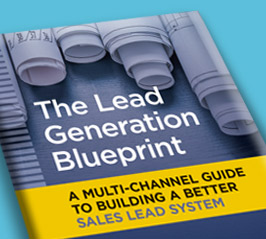
Lead Magnets & Lead Funnels
Lead generation can take many paths.
Whenever you are running any type of promotion – whether it’s direct mail or digital – there is usually some type of call-to-action (or CTA) involved.
Many companies use CTAs like a free consultation, a free demonstration, a free quote or some variation that will require an engagement with the prospect.
This is what most sales reps want – a prospect who is ready to engage.
But the reality is these types of CTAs don’t usually produce sufficient quantity to keep those sales reps busy.
They love the leads, but they can’t get enough of them to fill their calendar – without increasing their budget.
One way to turn up the response volume (without increasing your budget), is to use a lead magnet.
What is a lead magnet?
Just as it sounds, a lead magnet is designed to attract response – and we do that by creating informational materials that appeal to our prospects.
Things like an ebook, a special report, a white paper, a video tutorial, a tip sheet and a Q&A brochure all make good lead magnets – assuming, of course, the content is useful to your target audience.
Lead magnets are created in part to pass along helpful to your target audience, but also to demonstrate your own knowledge and experience.
What is an Information Kit?
An information kit is a package of information about your company, your products, your services and your success stories.
Although it is less informational, less educational and less appealing than a lead magnet, it does provide information your prospects may want – assuming they have some interest in what you offer.
It is also similar to a lead magnet in that the information can be conveyed via a pdf as a download or as a printed document.
Why do lead magnets and info kits increase your response?
It’s very simple – and it has to do with the level of engagement your prospect is willing to take when they first meet you.
More people are willing to download a lead magnet/info kit because the engagement is low – much lower than calls-to-action like a consultation, a demonstration or a quote request.
You can still push for a high-engagement meeting later in the process, but the lead magnet/info kit approach will deliver more responses at the outset.
How to create a lead magnet.
Step 1 – It starts by selecting a topic that you know would be of interest to your target audience – a topic that you know a bit about it and is related to what you sell.
This could be a how-to guide, or a step-by-step tutorial, or FAQ sheet with detailed answers, or a “numbered ways” to accomplish something.
Before you go too far with this, ask yourself is this something my audience would want, could benefit from? Do I know enough about this topic to write with authority? Is there broad enough appeal for this among my prospects?
Step 2 – Once you have a topic, consider the format. How will you convey this information – as a white paper, an ebook, a tip sheet, a special report or a video?
If you’re this as a multi-step how-to guide or tip sheet, map out the steps or points you going to make.
For example, if this is a 7-step guide to building a birdhouse, layout out your format by allocating space for each of the steps. Maybe a half page or full page per step. Then add an introduction for the front, and an “about us” section for back, plus a next step call-to-action. And you have your layout.
Step 3 – Add your content. Start writing the headlines and text for each of the steps as well as the intro, about us and final CTA. Try to keep each step of equal length. Spruce it up with an interesting design and some photos and/or charts and graphs.
Step 4 – Develop some compelling titles. The title of your lead magnet is probably the single important piece in terms of generating response.
The title needs to grab them and make them want to have what you created. And your title will do that.
We often use two titles – a short, compelling main title and a longer, more explanatory sub-title.
Develop several strong titles – and test them to see which pulls better.
Step 5 – Create a thumbnail version of the cover. When you offer your lead magnet – in direct mail, email, ads or your website – it’s always best to show the cover of the lead magnet. Let people know what they are getting.
Remember too when you develop your titles and place them on the front cover, make sure they are readable even when the cover page has been reduced to a thumbnail size.
————
Information Kits are usually easier and less expensive to create. They can usually be a developed with a collection of existing materials or content from your website.
We often recommend information kits when there is no budget for lead magnet.
They don’t usually work as well as lead magnets, but they do provide your prospects with a downloadable piece of content – which will increase your lead volume.
Need help creating a lead magnet?
We’ve done many of them, and we’d be glad to show you some samples.
We can also give you a quote.
Click on the link below to schedule a phone call or Zoom meeting.
Let's schedule a FREE Strategy Session
Do you have any questions? Would you like to know more?
Then let's schedule a one-on-one Zoom Strategy Session. There's no obligation. Just a chance to get some answers.
If you prefer, you can schedule your demo by phone at 508-473-8643,


